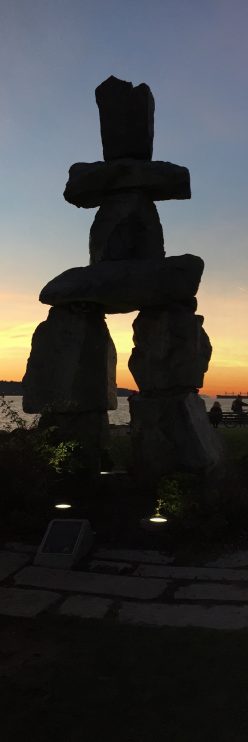When I was researching The Indian Act of 1876, I was hoping to read through the original, yet I could not find it. However, what I came across ended up being a little more disturbing than anticipated because it was the Indian Act of 1985 which is in effect today. I learned a lot about the Indian Act of 1876 a couple years ago in an anthropology course and it was gone over several times in various courses through my degree yet for some reason I no longer thought of it as being currently enforced. I am not sure why this didn’t click before as I have been on several reservations, one in Fort McMurray (where my British Father taught English in 1965 when he immigrated here), one south of Edmonton (Hobbema) and under Lions’ Gate Bridge (Squamish Nation). I came across this blog post, The Ugly Face of the Squamish Nation which I will return to in a bit along with the story of my father.
The major aspect of the Act that stuck out to me related to Indian women who married non-Indian men. I remember learning this in an Anthropology of Gender class. We had a guest speaker, a lawyer, Aboriginal, a Woman. She spoke about how at first there had been peace but things really changed when this act was introduced. She told stories about how women lost their status but the really problematic change was that they lost their names which had profound effects as many followed maternal lines, not paternal as it became with the introduction of the Indian Act of 1876. When Indian women married non-Indian, the women lost all of their rights as an Indian. Benefits, the right to family property, and the right to be buried with the ancestors. Essentially, they became “civilized,” as Coleman puts it in relation to White Civility.
The women than became “white” and became assimilated to a new world. The children of these marriages would marry other people of European decent, they would have no choice as all ties are cut when the Indian woman married a non-Indian man. I am white, my mother is darker, my grandmother even more so. I never saw a photo of my great-grandmother, it never existed but I suspect she was even darker. Each of these women married a non-Indian and there is now no need to assimilate me as it was done over generations and through genetic manipulation which was the goal of colonization.
Even today, the wording of the act still includes:
Indian Register
- 5 (1) There shall be maintained in the Department an Indian Register in which shall be recorded the name of every person who is entitled to be registered as an Indian under this Act.
This is the current terminology and it reminded me of what Trump is suggesting with keeping a registry of all Muslims in the United States. It is very unfortunate that this system still exists as it was established as form of control such as requiring permission slips to leave the reservation. The act prohibited alcohol consumption. The list of ways in which it controlled is endless.
So the above mentioned blog post discusses how the Squamish Nation Reservation is ugly and why can’t they just improve the area given how much money they have. Well, regardless of if they have money or not, money does not heal the destruction of your way of life. Some argue that was generations ago but it wasn’t. Residential schools were in operation during my lifetime. Unfortunately I believe that our society has a tendency to downplay the effect of trauma on people’s lives. Money doesn’t solve intergenerational trauma.
Regarding my British father was teaching English in 1965 in Alberta. He came here to escape a painful divorce. He arrived in Fort MacMurray and taught on a reservation in a one room school. He loved his students and they loved him. He had them draw and tell him their stories, it was English after all. But after about five years, he was fired. His methods were not English enough. They weren’t appropriate for teaching English. You can’t have your students drawing and having fun. He moved to Edmonton and was unable to find a job as a teacher in the Public School board, this was 1971. He instead married my mother, a student in University. He entered law school in 1975 and to this day works predominantly for Aboriginal women. He takes child welfare cases to help fight the systemic abuse that occurs.
I feel like sometimes we forget that even though the stories of “Canada” come from a perspective of colonization, not all people who were European supported to this view. My father exposed me to a world that most “white” people never get a chance to see (in all of its glory and suffering) and I am grateful because without it I would have zero connection to my ancestors dating back over 10,000 years in Canada.
I hope these stories provided support that Coleman’s argument isn’t just an argument, it is real. I am proof. I realize I went way over words allowed but I had to get it all out. If you got through it all, thank you! I guess in a way this is my creation story. My only wish is that I knew my great-grandmother’s maiden name, or her mother’s name. My grandmother already had a Scottish last name. Now I have a very British last name, Fish. It is traced back to the 1500s. I have traced my grandfather’s line back to the 1500s in Prussia (Mennonite). Yet, my grandmother’s line is gone. All I know is that my maternal line is from Northern Manitoba.
I apologize for using “Indian” but it was difficult to escape. I would prefer First Nations or Aboriginal.
Colleen
Works Cited
Government of Canada http://laws-lois.justice.gc.ca/eng/acts/i-5/ Accessed October 28, 2016.
Bob Joseph (blog) http://www.ictinc.ca/blog/21-things-you-may-not-have-known-about-the-indian-act-
Leslie, John http://www.revparl.ca/english/issue.asp?art=255¶m=83

